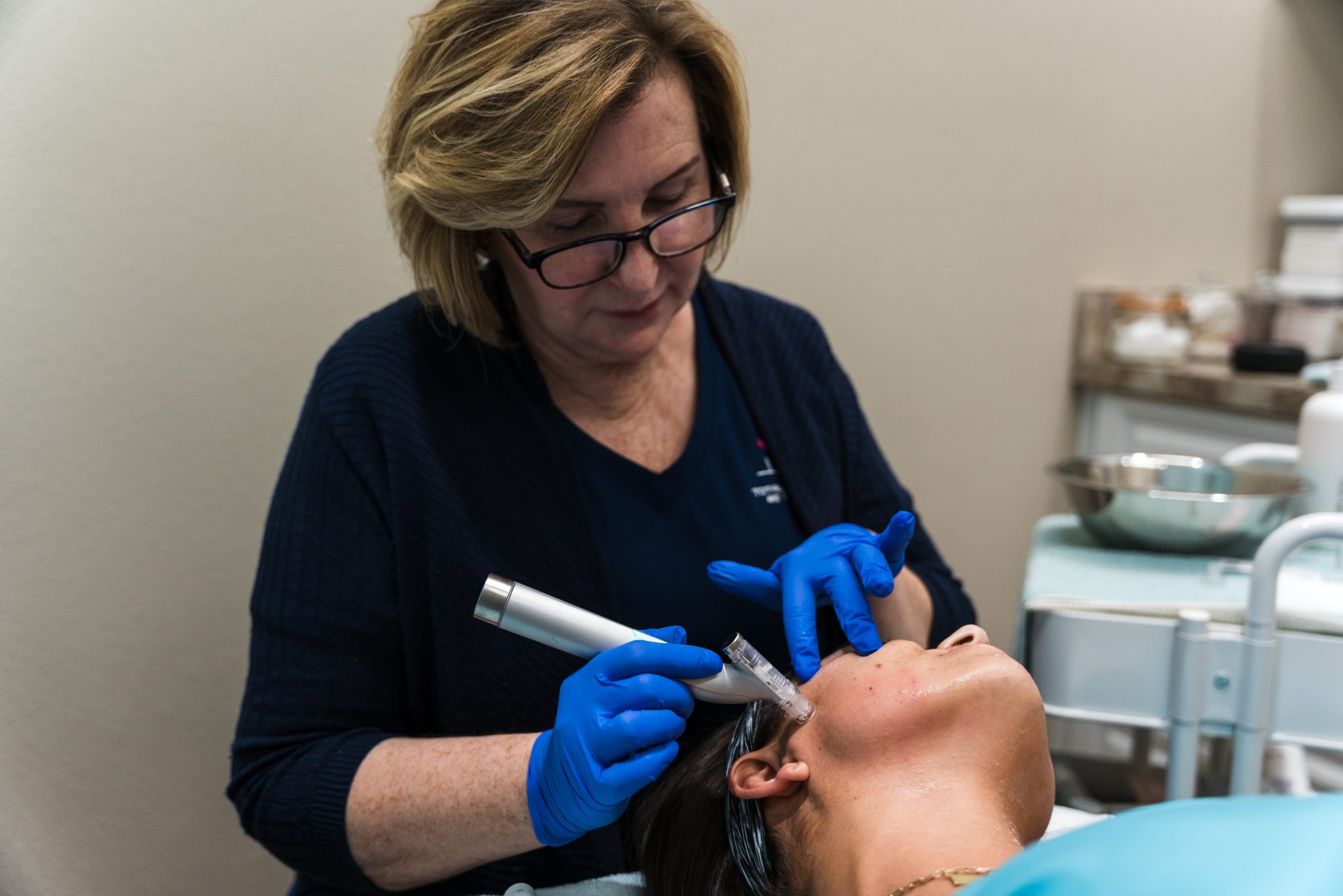A healthy diet and exercise offer a great start on your journey to total health…

November is Diabetes Awareness Month
Diabetes is a devastating disease that affects hundreds of millions of people around the globe. While many of its causes are known, just as many remain a mystery to scientists and doctors. That’s why we take November to celebrate Diabetes Awareness Month–a full 30 days to acknowledge and address a disease that wields the power to take control of your life.
However, thanks to the work of doctors and scientists done over decades, we’re now beginning to take control of diabetes and our lives. Diabetes is a subject all too personal to us here at Total Nutrition & Therapeutics. In fact, this disease spurred the very founding of this organization, which aims to improve health and well-being through the latest information and technology in nutrition and fitness.
In 2005, Lori Esarey was discussing with a group of friends exactly what she could do to make real change. A diabetic herself, Lori set herself to improving the health of hundreds through her new company, Total Nutrition & Therapeutics. She recognized, in the small subsection of clients who weren’t improving, a ‘breakdown in metabolism,’ as Lori tends to put it. Recognizing her own struggle, Lori has created a nutrition plan that attacks the unique challenges presented by diabetes.
It’s the fight against diabetes that’s channeled Lori’s passion for health. So today, we’re going to talk about all things diabetes–what it is, how we get it, and what we can do to prevent and suppress it.
What is diabetes?
There are two types of diabetes: Type I and Type II. Both types can be quite challenging to deal with–even deadly if left untreated.
Both impact the body’s ability to process partially digested sugar, called glucose. However, they are also opposites in a way, as one limits the body’s ability to store energy from food, while the second makes the body unable to process energy from food.
Insulin is the key to cell walls
Many of you may know that diabetes affects our ability to process carbohydrates, especially simple carbs. However, the disease really originates with insulin, which is a hormone integral to digestion.
And when we refer to sugar, we’re referring to something different than how it’s commonly understood. We’re referring to all foods that are broken down into glucose, known as carbohydrates, which represent the crust and caramel all the way to the very core of a candied apple. Carbs are in so many foods we eat in these modern times, making diabetes such a devastating disease.
Every one of our body’s cells requires glucose to function. It’s our main energy source. Without the key to our cells–or with a broken key–glucose can’t enter our cells, and our bodies begin to suffer imperatively.
Insulin is that key, and diabetes’ main effects are on insulin.
Type I diabetes
Type I diabetes is a disease in which the pancreas produces little or no insulin. This means that type I diabetes prevents our cells from receiving glucose, and therefore we fail to convert foods into energy–especially carbohydrates such as bread and pasta. It means that we have no key.
We believe that this is the result of our immune systems attacking the pancreas by mistake, thus limiting or eradicating our ability to produce insulin.
Type I diabetes is most often found in children as it develops out of genetic mutations and begins affecting the body at a young age. Hence, type I diabetes is referred to as juvenile diabetes. Type I diabetes can also result from certain illnesses, which also affect young children, who are most vulnerable. However, it’s important to note that type I diabetes can affect people of all ages.
Those suffering from type I diabetes will experience fatigue, thirst, frequent urination, and extreme hunger. This is because, without glucose in your body’s cells, there is no way to create the energy necessary for our most basic functions.
Type II diabetes
Type II diabetes–far more common than type I–is a disease in which the body is resistant to insulin. Think of type II diabetes as the disease that breaks the key to our cell walls so that it doesn’t work, and glucose can’t get in.
Type II diabetes tends to originate in adults, particularly those who maintain poor diets high in sugar and simple carbs. Contributing factors include sedentary lifestyles, alcohol use/abuse, and smoking.
Think of type II diabetes as a key that has been worn out after too much use. Insulin becomes desensitized to carbs entering the body because it has been repetitively inundated with sugar. Now, the body can no longer process it, and our blood is flooded with ineffectual glucose.
The symptoms of type II diabetes mirror type I, as the results of missing or malfunctioning insulin, are nearly identical. And while rarer than type I diabetes, the portion of type II patients is rising in its target demographic, children, which is being monitored heavily moving forward, as this affliction remains for the entirety of their lives.
How to treat types I and II diabetes
As of this writing, there is no known cure for either type I or type II diabetes. However, there is good news: scientists and doctors have come a long way toward identifying, understanding, and treating diabetes.
Though the causes of types I and II diabetes are different, the symptoms are quite similar. This goes for their respective treatments as well; while we treat each type of diabetes differently, the effect is similar–to allow the body to properly process glucose.
Lori’s mission starts with food. According to Total Nutrition’s founder and CEO, nutrition is the first and foremost weapon one can wield to fight this disease. However, used against yourself, it can also be deadly.
Treating type I diabetes
While type I diabetes is easily treatable with self-administered insulin created from recombinant DNA, the treatment is both tedious and arduous.
Those afflicted by type I diabetes must inject themselves daily–often multiple times a day–with this insulin. However, these injections must be timely, meaning that the afflicted person must adhere to their scheduled shots or suffer the dire consequences.
Treating type II diabetes
The treatments for type II diabetes are, unfortunately, not as straightforward. But they are less arduous than treatments for type I diabetes.
Though there is a genetic component, the chances of developing type II diabetes rise significantly in individuals who consume large quantities of simple carbohydrates and lead sedentary lifestyles.
The simplest treatment for type II diabetes is to maintain a healthier diet and get plenty of exercise. Lowering your intake of simple carbs will allow your body–and insulin–a break from trying to process so much glucose. Exercise will not only help you produce more insulin, but it has been shown that it can also re-sensitize your insulin to glucose, making it easier for your body to process glucose again.
The truth is in total nutrition
For both forms of diabetes, the most effective and immediate remedy is diet.
Diabetes thrives on the body’s inability to process sugar. Those suffering from both types of diabetes will beat this disease through constant nutritive vigilance, which means staying away from sugar in its purest form, whether natural or manufactured.
It might seem counterintuitive. How can a disease that limits the body’s ability to utilize sugar be counteracted best through minimizing the intake of sugar and simple carbohydrates? Well, according to Lori and the Total Nutrition team, for those with diabetes, limiting sugar and simple carbs eases the pressure on our compromised insulin system. By eating proteins, healthy fats, and complex carbs such as vegetables, lean meats, and a limited amount of fruit, we readily process our energy. Furthermore, we often allow our insulin systems to ‘re-sensitize’ to glucose, meaning that, taken slowly, through the ingestion of healthy foods, our pancreas and insulin can relearn how to process glucose energy.
However, a corrective diet doesn’t end with eliminating carbs and unhealthy fats. it’s vital that those suffering from diabetes confer with medical professionals about their diet. Lifestyle habits such as poor sleep, food intolerances, and hidden gastrointestinal imbalances, and chronic infections may be at the root of diabetic emergence. These often hidden metabolic disruptors explain why a change in diet, including the removal of carbs alone, isn’t enough. Digging deep with an integrative provider at Total Nutrition & Therapeutics can help patients find the true driver and, perhaps, once and for all, find real, lasting solutions.
Combating diabetes through awareness
Diabetes awareness month helps us keep this widespread disease in the minds of the scientists and doctors who might choose a path in this direction. But it also better educates the public on the risk factors and consequences associated with diabetes.
Better yet, it’s a chance for all of us to pitch in on the effort to fight this deadly affliction. Even if everyone gave just a few dollars or started a fundraiser, it would go miles toward funding the research and experimentation necessary to discover new treatments and, hopefully, one day, a cure.
Lori Esarey started Total Nutrition & Therapeutics on the basis of restoring health and wellbeing through healthier eating and fitness. However, it’s this pernicious disease–diabetes–that showed her just how impactful a change in diet and lifestyle could be. This means that Diabetes Awareness Month isn’t only for those who suffer from the disease; It’s for everyone, as this disease can affect us all at any given moment should we stray from the principles laid out by Lori and the Total Nutrition team.
Contact Total Nutrition and Therapeutics for more information about diabetes.
Diabetes affects hundreds of millions of people around the globe. Total Nutrition and Therapeutics takes this disease personally by staying updated on the latest treatments and information. Visit our website to find out more about what Total Nutrition and Therapeutics is doing to fight diabetes!



